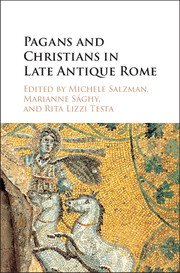 Pagans and Christians in Late Antique Rome
Pagans and Christians in Late Antique Rome Book contents
- Frontmatter
- Contents
- List of Illustrations
- Biographies of Authors
- Acknowledgments
- Introduction
- Part I SENATORIAL POLITICS AND RELIGIOUS CONFLICT
- Part II The Construction of New Religious Identities
- 4 Christians and the Invention of Paganism in the Late Roman Empire
- 5 Late Antique Divi and Imperial Priests of the Late Fourth and Early Fifth Centuries
- 6 Artis heu magicis : The Label of Magic in Fourth-Century Conflicts and Disputes
- 7 Crowd Behavior in Late Antique Rome
- Part III Pagans and Christians: Coexistence and Competition
- Section A Pagans and Religious Practices in Christian Rome
- Section B Death and the Afterlife
- Section C Reading Religious Iconography as Evidence for Pagan–Christian Relations
- Concluding Remarks: Vrbs Roma between Pagans and Christians
- Index
- References
6 - Artis heu magicis : The Label of Magic in Fourth-Century Conflicts and Disputes
from Part II - The Construction of New Religious Identities
Published online by Cambridge University Press: 05 November 2015
- Frontmatter
- Contents
- List of Illustrations
- Biographies of Authors
- Acknowledgments
- Introduction
- Part I SENATORIAL POLITICS AND RELIGIOUS CONFLICT
- Part II The Construction of New Religious Identities
- 4 Christians and the Invention of Paganism in the Late Roman Empire
- 5 Late Antique Divi and Imperial Priests of the Late Fourth and Early Fifth Centuries
- 6 Artis heu magicis : The Label of Magic in Fourth-Century Conflicts and Disputes
- 7 Crowd Behavior in Late Antique Rome
- Part III Pagans and Christians: Coexistence and Competition
- Section A Pagans and Religious Practices in Christian Rome
- Section B Death and the Afterlife
- Section C Reading Religious Iconography as Evidence for Pagan–Christian Relations
- Concluding Remarks: Vrbs Roma between Pagans and Christians
- Index
- References
Summary
“Alas, while seeking the honours of nobility by your magic arts / you are brought thus low, wretch, rewarded with a tiny tomb.” In this way, an unnamed pagan Roman senator is accused of practicing the magic arts (artis … magicis) in the anonymous pamphlet poem often called Carmen contra paganos. The same poem, near the end of the work, also mentions the “magic incantations” (carminibus magicis) of the widow of the wretched senator.
This is only one example of the many labels of magic attached either to religious rivals or to political opponents in the fourth century. This chapter aims to analyze and contextualize the category of magic pinned onto pagan cults and heresies in the fourth century. Magic has served as a resourceful and versatile word in interreligious and intra-religious disputes and conflicts. One of the easiest ways to produce differences and create boundaries between groups has been to label the practices and beliefs of a rival group as magic.
Defining Magic
In this chapter, magic is understood as a discursive category that depends on the perspective of the perceiver. Therefore, there is no such thing as magic in itself. Instead, we should speak of rituals, beliefs, and texts that receive, usually from those situated outside such a context, the label of being magical. In this delineation, magic is a socially constructed object of knowledge whose content and formulations vary according to different social contexts and circumstances.
If we need to define magic, phrases such as “unsanctioned religious activity,” “ritual power,” or “extra-cultic ritual practices” will be adequate. We can also refer to alternative, deviant, private, often unaccepted, forms of ritual behavior as some modern scholars have done. A number of researchers have ended up using the term magic as a heuristic tool, a comparative term applied in an etic perspective, that is, perceived from the outside. This is pragmatic indeed as long as one remembers one is using the term magic as a heuristic tool. However, this solution is problematic insofar as researchers run the risk of making more or less subjective distinctions between what they regard as magic and what they regard as religion. In the scholarship of the recent decades, the conventional distinction between religion and magic has increasingly been challenged as untenable.
- Type
- Chapter
- Information
- Pagans and Christians in Late Antique RomeConflict, Competition, and Coexistence in the Fourth Century, pp. 162 - 177Publisher: Cambridge University PressPrint publication year: 2015
References
- 2
- Cited by


